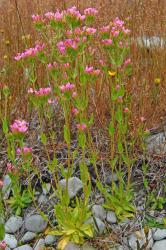- Taxon
- Gallery
- = Gentiana centaurium L.
- ≡ Erythraea centaurium (L.) Borkh.
- = Centaurium minus Garsault (1764) nom. illeg., nom. inval.
- = Centaurium umbellatum Gilib. (1781) nom. inval.
Glabrous, erect annual or biennial with usually simple stems to c. 50 cm high and rosette of basal lvs persisting until after flowering. Basal lvs 1–4 × 0.5–2.2 cm, elliptic to obovate, 3–5-veined; apex rounded to ± mucronate. Cauline lvs smaller and narrower than basal, 3-veined; apex obtuse to acute. Infl. a corymbiform cyme; fls usually dense, sessile or shortly pedicellate. Bracts linear to lanceolate, > calyx. Calyx 4–6 mm long; lobes narrow-linear. Corolla 10–14 mm long; tube narrow- cylindric, white, pink towards apex; lobes 5–7 × c. 2 mm, elliptic, patent, usually pink, rarely white, obtuse or subacute. Stamens < corolla lobes. Capsule 8–10 mm long, fusiform. Seeds alveolate, minute, c. 0.2 mm long.
[From: Webb et al. (1988) Flora of New Zealand. Volume 4.]
Flowering: (Sep.)–Nov.–Apr.–(Jun.)




